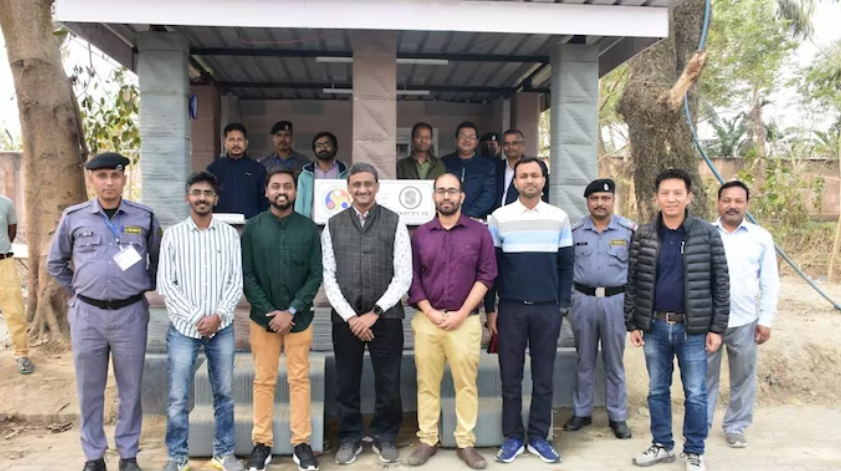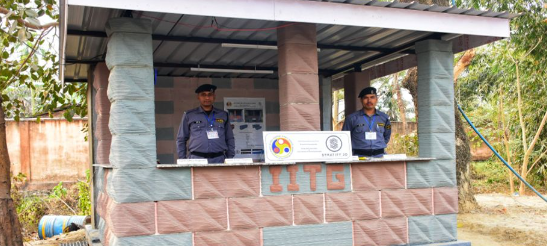IIT Guwahati has built a 3D printed security post out of a novel M40-grade sustainable concrete that included industrial waste, fibers, and chemical additives, as part of the G20 Summit initiatives.
The team of Dodda Srinivas, Dhrutiman Dey, and Akshay Sahu founded Stratify 3D Pvt. Ltd. under the guidance of Dr. Biranchi Panda, Assistant Professor, IIT Guwahati, and established this digital technology in connection with India’s Prime Minister Narendra Modi’s ‘AatmaNirbhar Bharat‘ vision. This automated and novel technology established at IIT Guwahati is fully prepared to offer customized homes in India with better quality control and short lead times.
“In this project, we addressed the aesthetic potential of digital construction technology while utilizing sustainable construction materials. Material and surface texture demonstrates the remarkable aesthetic possibilities of concrete printing technology used for the security post-construction,” said Dr. Biranchi Panda, Assistant Professor Mechanical Department, IIT Guwahati.

Characteristics of this novel sustainable 3D printed security post
The security post was constructed in alliance with the Institute’s Infrastructure, Planning, and Management team and is said to be environmentally friendly in aspects of material and construction composition. The 3D security post has a carpet area of 85 square feet and 56 modules. The team 3D printed custom-designed tetrahedron modules with overhang attributes of 22 degrees and engraved features up to 40 mm for the first time.
To print the overhanging attributes, a special sustainable concrete mix layout (patent pending) with distinct accelerator and retarder configurations that fulfill the demanding mechanical and rheological performance standards of a 3D printed structure was created. The components were printed in 15 hours employing an automated concrete 3D printer and then gathered on-site with a special bonding material.
The construction industry accounts for 13% of GDP and accounts for roughly 40% of overall carbon dioxide (CO2) emissions. Newer technologies like 3D printing are essential for accomplishing a circular construction economy. This necessitates the introduction of novel multi-functional eco-friendly materials obtained from industrial waste, according to IIT Guwahati.
The on-site arrangement and technology illustration of this 3D printed security post was also featured at the Y20 Inception Meet at IIT Guwahati. In the presence of Superintendent Engineer Col. L.K. Singh (Retd.), Professor Parameswar K. Iyer, Officiating Director, IIT Guwahati, Dr. Biranchi Panda, Assistant Professor, IIT Guwahati, Associate Dean IPM KD Singh, and the Stratify 3D team, the post was therefore officially handed over to security staff to begin operations.

Advancing sustainable construction 3D printing
Previously, in collaboration with Eindhoven-based housing developer Lab040, global 3D concrete printing company CyBe, intended to construct the world’s first 3D printed four-story apartment. The Prefabricated Prefinished Volumetric Construction (PPVC) method will be used for the CyBe project, says the company. According to CyBe, PPVC can be employed to construct finished components off-site for on-site implementation. In regulated manufacturing environments, 3D components are developed utilizing this modular construction technology and superior construction methods and materials. “CyBe Mortar sets in three minutes and achieves structural strength in one hour,” according to the company. As per CyBe Construction, its PPVC system for 3D concrete printing cuts conventional building costs in half. Berry Hendricks, CEO of CyBe said, “This vision is in the DNA of the CyBe organization. For CyBe, this means enabling companies to build faster with fewer resources, producing affordable, sustainable, and ecologically durable constructions.”
Furthermore, Californian construction firm Mighty Buildings announced the arrival of the world’s first 3D printed energy-efficient home. The two-bed, two-bath home, built from 3D printed prefab panels, is the first in a society of at least 40 residential units at a site in Southern California. In addition to completing the structure, which generates as much energy as it consumes, the company also announced plans to broaden its B2B offering in hopes of providing eco-friendly homes on a larger scale.
What does the future of 3D printing for the next ten years hold?
What engineering challenges will need to be tackled in the additive manufacturing sector in the coming decade?
To stay up to date with the latest 3D printing news, don’t forget to subscribe to the 3D Printing Industry newsletter or follow us on Twitter, or like our page on Facebook.
While you’re here, why not subscribe to our Youtube channel? Featuring discussion, debriefs, video shorts, and webinar replays.
Are you looking for a job in the additive manufacturing industry? Visit 3D Printing Jobs for a selection of roles in the industry.
Featured image shows IIT Guwahati and Stratify 3D team. Image via IIT Guwahati.



